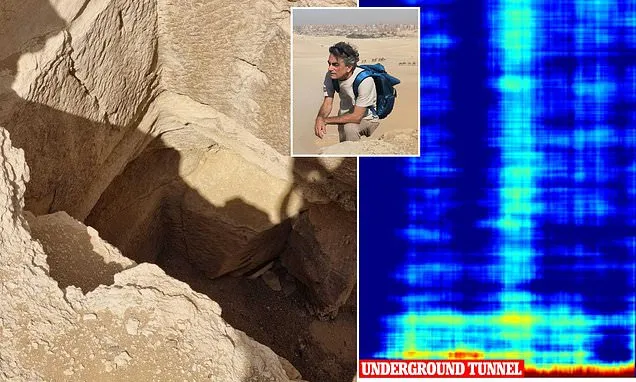On the northeastern edge of the Giza Plateau, I discovered three perfectly cut shafts hidden beneath the sands.
They sit in the triangle between the Great Sphinx, Khufu's Pyramid and Khafre's Pyramid, and may open into a long-forgotten underground world.
These are not water wells. They bear no inscriptions, no signs of casual digging, and their geometry is too precise, their walls too smooth, their design too deliberate.
Could these shafts be the keys to the network of hidden chambers the Greek philosopher Herodotus once whispered about, possibly connected to the Nile?
Herodotus described a massive 'labyrinth' in Egypt with 3,000 chambers, many hidden below ground, which included and a large underground pyramid.
Explorers in the 1800s, like Giovanni Caviglia and Henry Salt, recorded strange wells near the Sphinx and Khafre's causeway.
French archaeologist Pierre-Jean Mariette mapped additional anomalies in 1864 and 1885, and scholars like George Reisner, Hermann Junker, and Selim Hassan traced a line of cavities between the Sphinx and Khafre's Pyramid between 1929 and 1939.
After that, the area was largely forgotten. Fragments of those old reports hinted at a larger pattern, one pointing to a vast, interconnected world beneath the plateau.
Now, the three shafts I rediscovered may unlock that hidden map.
The first shaft, northeast of the Sphinx, has a square limestone mouth and plunges 130 feet -- the height of a 12-story building. Its walls are precisely squared and lined with limestone and sandstone blocks, resembling the structure of some ancient machine.
Egyptologist Armando Mei and his team with the Khafre Project have been studying Egypt's Giza Plateau for years, using advanced technologies to uncover hidden structures below the surface.
I came across the shafts while conducting fieldwork with the Khafre Research Project, where I serve as a researcher.
Our team, including Professor Corrado Malanga and engineer Filippo Biondi, used Synthetic Aperture Radar (SAR) satellite technology to investigate subsurface structures beneath Giza.
Guided by these spectral traces, we located the shafts, still standing, perfectly cut and utterly enigmatic.
The first shaft lies northeast of the Sphinx. Its square mouth, framed by limestone blocks, plunges 130 feet, about the height of a 12-story building.
Its walls are squared with astonishing precision, lined with limestone and sandstone blocks that resemble the walls of some ancient machine.
At a depth of 40 feet, an 80-foot-wide cavity encircles the shaft, too intentional to be natural erosion.
Satellite imaging suggested it continues even deeper beneath the rubble.
Just feet away, the second shaft mirrors the first. Located beside Khafre's processional causeway, a covered ramp linking the Valley Temple to the area near his pyramid, it features the same smooth precision and perimeter channel.
Forty feet down, an 80-foot-wide cavity encircles the first shaft, clearly too deliberate to be natural. Satellite imaging indicates it extends even deeper beneath the rubble.
Just feet away, the second shaft mirrors the first. Beside Khafre's processional causeway, a covered ramp connecting the Valley Temple to his pyramid, it shows the same smooth precision and perimeter channel.
Two shafts built to identical specifications suggest a deliberate system rather than randomness.
The third shaft, on the eastern side of Khufu's Pyramid, is the most intriguing. Its entrance was once reinforced with retaining blocks, hinting at frequent access.
A recess cut into the west wall appears designed to lift or guide objects from below. The surrounding cavity again appears, perfectly measured.
Less than 165 feet separate the three, forming a pattern too deliberate to ignore. When mapped, their alignment mirrors the three great pyramids themselves, with a resemblance to Orion's Belt that is uncanny.
Two smaller, rougher shafts nearby seem to be later additions. They lack the depth and polish of the originals, suggesting imitation rather than original intent.
Even so, they hint at the underground's complexity, reminding us that Giza is far from fully explored.
The purpose of these shafts remains uncertain. Were they for ritual offerings, hydraulic systems, or vertical transport chambers?
Modern imaging, including Ground-Penetrating Radar, Electrical Resistivity Tomography and our own SAR technology, reveals further anomalies near the Sphinx, hinting at interconnected cavities beneath the plateau.
Might these shafts unlock the hidden network of chambers that Herodotus once spoke of, perhaps even linked to the Nile? The Greek historian described a vast 'labyrinth' in Egypt, containing some 3,000 underground chambers, including a massive subterranean pyramid.
The third shaft, on the eastern side of Khufu's Pyramid, is the most compelling. Its entrance was reinforced with retaining blocks, suggesting frequent use; while a recess in the west wall seems built to lift or guide objects from below.
If confirmed, these shafts could be entry points to a vast engineered network aligned with the pyramids themselves.
Beneath the plateau, trenches and sockets carved in limestone along with deep rock-cut shafts and wells show that builders engineered underground with same care as monuments above.
This hidden dimension has fueled speculation about subterranean chambers and hydraulic systems possibly connected to Nile; suggests purpose far beyond what conventional archaeology has recognized.
The precision and alignment of these shafts coupled with their mirrored pattern of pyramids hint at a cosmic and terrestrial plan interwoven above and below ground.
For decades, the true extent of Giza's underground world has been overlooked; but these shafts may finally reveal a lost chapter of ancient engineering and ceremonial practice.
What lies at the bottom of these shafts remains a mystery. Yet every measurement, every radar image points to a singular conclusion: the Giza Plateau still holds secrets that could reshape our understanding of ancient Egypt.
The shafts are more than anomalies; they are doorways into a subterranean world waiting to be explored.
